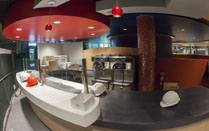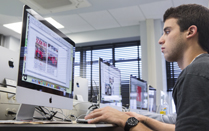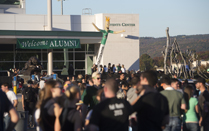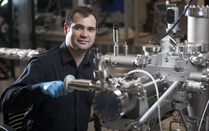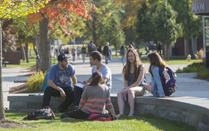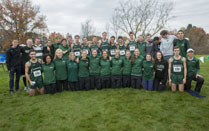Binghamton University President Harvey Stenger's Quarterly Report - December 31, 2013
As we come to the end of the fall semester and prepare for the new year, I would like to reflect on some of the University’s achievements since classes began in September. While we’ve not had any excitement comparable to President Barrack Obama’s visit in August, it was nonetheless a very busy and productive quarter, highlighted by implementation of key features of our Road Map, a significant expansion of enrollment as well as faculty hiring, and increasing contributions to the economic health and well-being of our community and state.
Reading this last sentence, I realize that much of the work that a University does can sound dry and abstract, so it is always important to look around and see the real impact that the University has on the lives of our students, graduates, and friends in the community. So let me begin this review by mentioning some of the events and activities where the University touched people in a direct and visible way.
The past semester offered numerous occasions for celebration and excitement for students and alumni. In October, we held a very successful Homecoming, with more than 600 alumni in attendance. I enjoyed watching them reconnect with the University and marvel at the changes that have taken place since they were students. But Homecoming offers much more than an opportunity to reminisce with classmates and professors; these days our Homecomings are as much about networking and engaging as they are about sports and entertainment, with conferences and panel discussions on a variety of topics of interest to graduates at all stages of their careers.
In December, we also celebrated the achievements of our newest alumni at the annual Fall Commencement. More than 700 students graduated from the University this semester, and over 400 of them walked across the stage during the Commencement ceremony at the Events Center. Former President Lois B. DeFleur, who served the campus for nearly two decades, was among those in the audience. Her efforts were crucial at a time when the University’s mission was changing, and help make this an internationally recognized research university. As I told the Commencement audience, the campus and community owe her — and all of our previous presidents — a great debt for their work to make this a remarkable University.
December is also the time when current students are busy finishing papers and projects and studying hard for exams. This can be a taxing few weeks for students. In an effort to lessen the tension, for the second year we embarked on “De-Stress December,” with daily activities designed to help students cope with the demands of approaching finals. Residential Life, the Office of the Dean of Students, Campus Recreation and Sodexo have worked together to provide students with free food, opportunities for exercise and stress-reducing recreation, including the always-popular “therapy puppies.”
Despite the challenges and concerns students face at the end of the semester, our campus community has come together to provide happiness for the children of the community. Each year students, faculty and staff give generously to holiday food and gift drives, and this year was no exception. In all, the campus community collected thousands of dollars for the local food bank and gathered toys for hundreds of local children through programs such as Hand-to-Heart, Operation SAnta, Toys for Tots and the annual Chanukah Toy Drive. These activities are important for the University, providing opportunities for students to develop connections with the community, for the campus to develop partnerships with local schools and charitable agencies, and most of all, to demonstrate that we are an engaged and supportive part of the community.
While the activities I’ve mentioned — Homecoming, Commencement, finals and holiday charity — are traditional aspects of life at Binghamton University, each of these has grown and evolved over the past year or two, as the University has received new revenues, implemented our Road Map and strengthened our connections to the local community. This trajectory suggests that next year will be even better!
IMPACT OF NYSUNY 2020 AND PREDICTABLE TUITION
One of the key features of NYSUNY 2020 is the Predictable Tuition Plan that has provided a burst of new resources for the campus at a critical point in our history. As I testified at a recent hearing held by the New York State Assembly Committee on Higher Education, predictable tuition has had an immense, positive impact at Binghamton. From the perspective of students and family, predictable tuition has made it possible to more accurately estimate college costs. Additionally, a significant portion of these funds has been set aside to provide support for economically disadvantaged students. But most importantly, it also has provided the resources to significantly expand our faculty — with a real effect both on student outcomes and University-led research and scholarship activities.
Clearly, NYSUNY 2020 has made a difference for our campus, particularly as we are now in the second year of our hiring initiative. During this period, the University has seen a net gain of 93 tenure-track faculty — 67 of them net new tenure-track faculty. Building on this success, we have 55 searches under way for the 2014-15 academic year, 32 of them will bring us net new faculty, putting us ahead of pace to meet our NYSUNY 2020 goal of 150 new faculty by 2017.
Talk about impact: These hires are helping us bring our student-to-faculty ratio down to our goal of 19:1, even as our student enrollment climbs toward our goal of 17,000 students by 2017. This ratio is one of the most effective measures of educational quality on college and university campuses, and our ability to reduce it will inevitably lead to higher-quality students and an increase in educational visibility and reputation.
We have approached these faculty hires from a strategic perspective, based not only on their impact on teaching but also with an eye to enhancing scholarship and research at Binghamton. While there has been hiring across the University, much of it has been concentrated in fields associated with our Transdisciplinary Areas of Excellence. Briefly, the TAE’s are broad areas of research and scholarship that address critical social, scientific, technologic, economic and cultural issues. Our five TAEs are: citizenship, rights, and cultural belonging; health sciences; material and visual worlds; smart energy; and sustainable communities. (See here for a more complete description).
Faculty have been very active in moving these TAEs forward, and the campus saw the first fruits of this when the Sustainable Communities TAE held a conference in October that drew approximately 75 participants and presenters from the University and the broader community. With Road Map funding, each TAE has also awarded its first round of seed grants to encourage faculty to develop collaborative projects that stimulate the advancement of new ideas that can build Binghamton University’s expertise toward a national reputation in their areas. In total, 13 grants were awarded and an RFP for a second round of competitive funding will be announced early in 2014. I have very high expectations for the TAEs as an organizing principle for cutting-edge research, scholarship and community outreach.
ROAD MAP PROGRESS
We also are moving forward on a number of projects identified as Road Map priorities. This year, we are funding 46 projects aligned under our five strategic priorities – Creative Activities, Learning Community, Inclusive Campus, Global Impact and Strategic Investments. Our Road Map Steering Committee has been divided into five teams that are developing metrics to assess our progress with regard to each strategic priority. We will be updating the University community regarding our progress on the Road Map website.
I also am very excited about the changes taking place in our Center for Learning and Teaching. With Road Map funding, the center is providing faculty support for educational excellence in a student-centered environment, using technology to help. For example, the CLT is supporting a number of our faculty who are now “flipping” courses, where students attend the lecture portion of the class online and do homework in the classroom. These flipped courses allow our faculty to see just where students might need assistance in grasping concepts, for a more student-focused learning experience.
Similarly, after an intense period of study, the Information Technology Services Task Force, which was led by Vice President Bahgat Sammakia, submitted its report to me. In response, I have appointed Joanne Navarro as interim chief information officer to oversee our Information Technology Services. She also will continue in her role as associate vice president for administrative services. This is an important position, as we want to leverage our technologies to increase campus innovation and improve technology in the classroom. For these reasons, we also have moved Educational Communications into the Division of Academic Affairs office, under the CLT.
ORGANIZATIONAL CHANGES
Susan Strehle, distinguished professor of English, has been named vice provost and dean of the Graduate School. She had been serving in an interim position since last January; we are pleased with the direction and progress the school has made over the past year, particularly with regard to recruiting and retention as well as significant changes to the Graduate School website.
Similarly, Laura Bronstein, professor of social work, also stepped up to serve in an interim capacity as dean of the College of Community and Public Affairs following the retirement of Founding Dean Patricia Ingraham. In December, Bronstein was appointed dean.
Meanwhile, the searches for a permanent CIO for Information Technology Services and for a permanent Vice President for Advancement are under way.
REGIONAL ECONOMIC DEVELOPMENT GROWTH
In addition to my work guiding the University, I’ve remained very busy co-chairing the Southern Tier Regional Economic Development Council (STREDC) with Corning executive Tom Tranter. I believe this role exemplifies how the University must remain fully invested in the economic health of our region. At the same time, I’ve been very clear about my role on this important council and have recused myself from any decisions involving the University. So, it is gratifying that the STREDC values the University’s role in promoting the region’s economic health.
In December, we were pleased to learn that our region was again named a “Top Performer” during Gov. Andrew M. Cuomo’s announcement of the 2013 REDC awards. The region will receive $81.9 million for more than 85 projects. This marked the second time in two years that the region was a “top-performer,” reflecting the area’s solid planning and our ability to pool resources and ideas to strengthen the region’s economy. All told, the region has been able to leverage more than $500 million in state and private investments over the past three years to support the region’s economic growth.
Binghamton University plays a major role in several of this year’s STREDC projects and will receive $750,000 to help us develop a research-based program that would provide all University undergraduate STEM students with an authentic research experience during their four years on campus.
In addition, the University also will be a key partner in the Southern Tier High Technology Incubator located in downtown Binghamton. This project, which was a priority in last year’s STREDC proposal, has helped earn the region the designation of “Innovation Hot Spot,” in partnership with Cornell University and Corning, Inc., and will receive a share of $250,000 from the state for support for the incubator.
We are also are working to support Gov. Andrew Cuomo’s START-UP NY initiative to encourage start-up companies. We have submitted the future downtown incubator as an eligible START-UP space, as well as the start-up suites on our Innovative Technologies campus. We have presented a draft plan to the Faculty Senate Executive Committee for how companies and space will be identified, and have incorporated the committee’s feedback into our final plan to Empire State Development. A number of local, regional and national firms have expressed interest in this partnership, and the first firm may arrive in early 2014.
Finally, I am pleased to have been appointed as a director to the board of The Research Foundation for the State University of New York, which provides essential sponsored programs administration and innovation support services to SUNY faculty and students. In my role, I am serving the board’s Research, Entrepreneurship and Innovation Committee.In early November, Binghamton University hosted a meeting of the board on campus.
Sincerely,

Harvey G. Stenger

